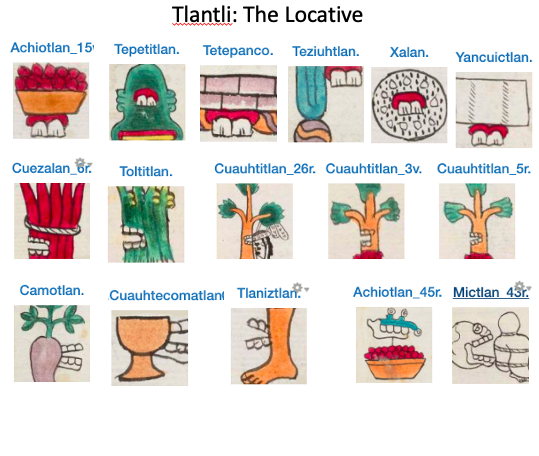10) Tlantli: Not "Tooth"

The the noun [tlān(tli)] (tooth, in the visual representation) shapes the hieroglyph representing the locative suffix -tlān (place of, at, by), which refers to a place where a modifier, such as a certain plant, is found. Dropping the -tli (absolutive ending) provides the phonetic -tlān. This locative suffix is attached at the end of a great many nouns (typically, but not entirely), creating place names. Besides being a place of abundance of a given thing, the suffix -tlān can be interpreted to mean many things, including: by, among, in, to, between, in the company of, below, or near.
The meaning "tooth" has nothing whatsoever to do with the locative of the place name, and yet the painters of glyphs could get very creative working teeth into a number of compound glyphs in a way that truly recalls teeth and mouths, as shown in the collection of examples in the image on the left. Tlantli is an inadvertent attention grabber and may even suggest some humor in the ways it was combined with other signs.
Two especially numerous examples of teeth in compound place names show the two front teeth imbedded in red gums. Six examples appear in the top row of the image on the left. The next row down shows how teeth could be imbedded in the shape of a mouth, as we see in feathers (see Cuezalan), in tule reeds (see Toltitlan), and in tree trunks (see the three examples from Cuauhtitlan). Teeth can also appear—almost like a set of dentures—protruding from an object, as in the case of a sweet potato (see Camotlan), a cup (see Cuauhtecomatlan), and and a leg (see Tlaniztlan). Occasionally, the teeth are imbedded in skeletal jaws (see Achiotlan and Mictlan in the lower right corner of the image to the left). Nextitlan provides an example where the upper and lower teeth of an open mouth appear, facing us in the midst of humid soil.
The postposition -titlan (at the base of, among, etc.) has a short a, according to Frances Karttunen. She also notes that the ligature -ti- does not appear before the suffix -tla (or -tlah, when marking the final saltillo), so a place name with a gloss ending in -titla should be titlan. [From an unpublished manuscript by Karttunen, "Critique of Glyph Catalogue in Berdan and Anawalt Edition of Codex Mendoza."]
(SW; more forthcoming)
